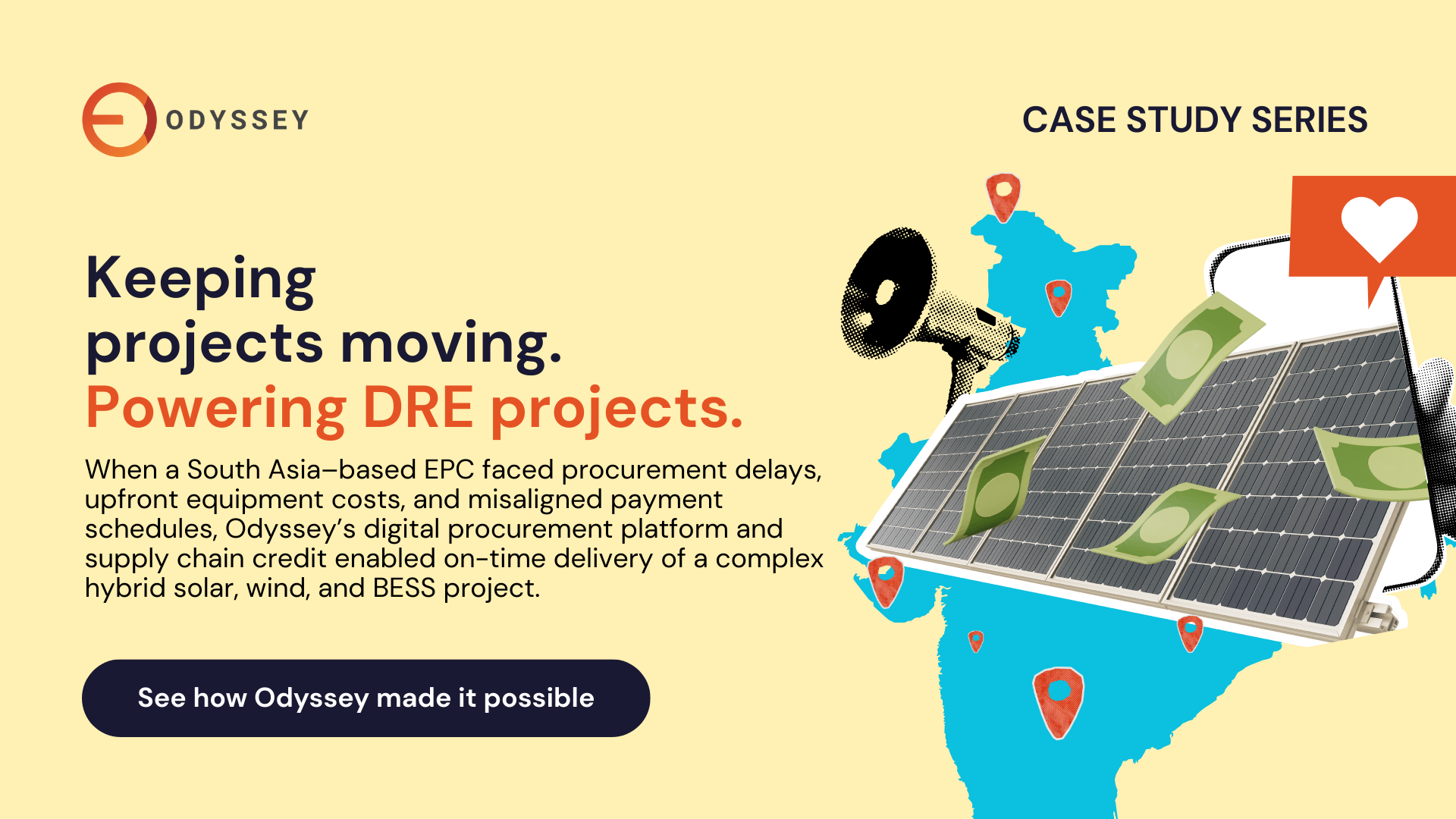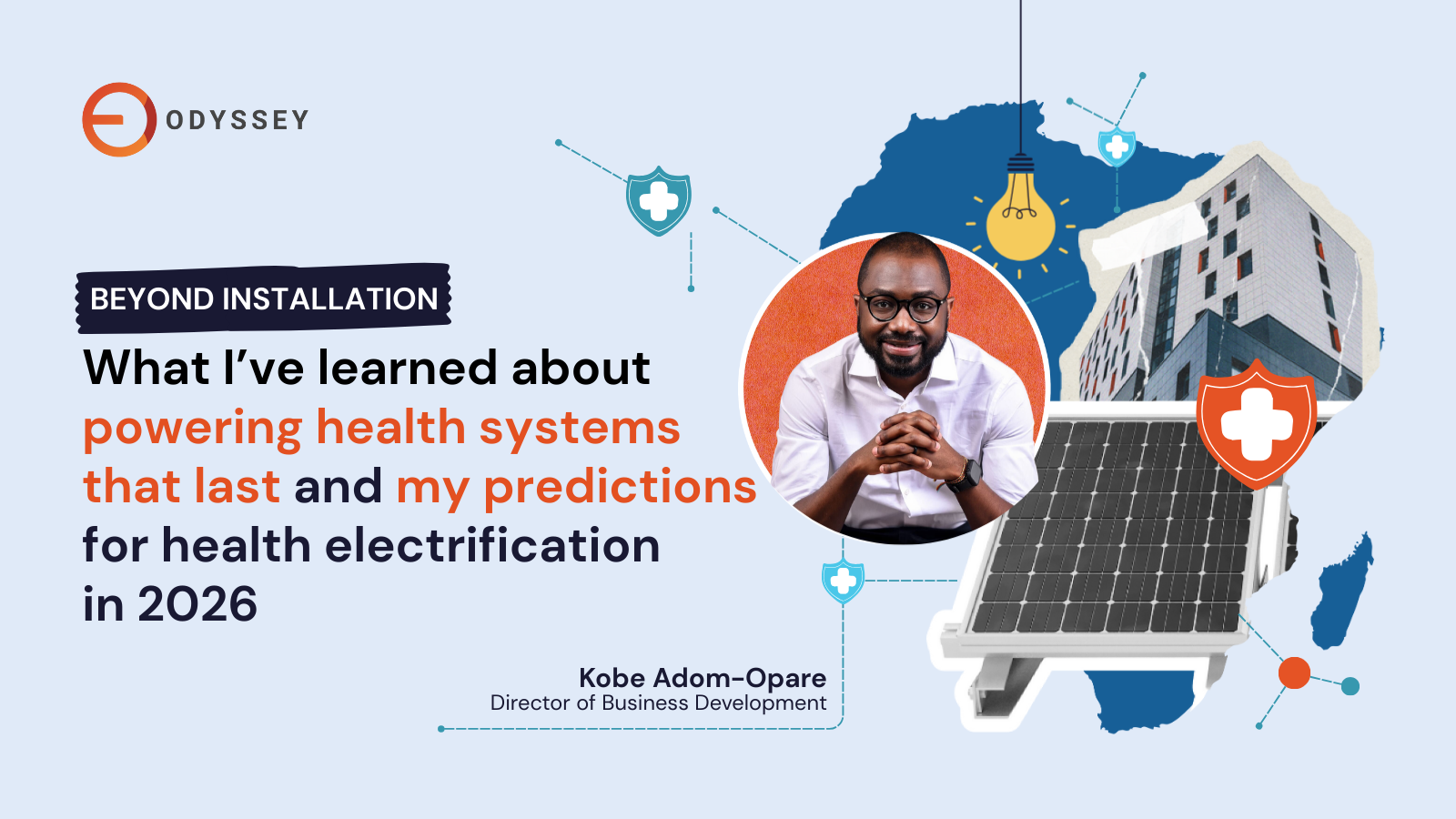Harnessing data for successful health facility electrification, improved healthcare delivery, and cost savings
Forty-one percent of health facilities in sub-Saharan Africa have unreliable electricity access, while 15% are completely without access. Odyssey works with financiers, local health ministries, and solar companies to bring electricity to health facilities across Africa and other emerging markets.
Odyssey’s remote monitoring and control technology is tailored for health facility electrification projects, providing the data and insights that funders and operators need to successfully implement and manage health electrification projects over time.
Remote monitoring and control is an integral part of any health facility electrification project. Without it, solar assets can fall into disrepair, their operating status can become unknown to funders and other stakeholders, and billing and system performance cannot be accurately managed. Conversely, successful implementation of remote monitoring technology leads to improvement in healthcare delivery, patient satisfaction, and cost savings. Monitoring technology in conjunction with health center surveys is a powerful combination that paints the full picture of how successfully a health center or portfolio of health centers is operating.
Below are three projects where remote monitoring and control has played a part in the roll-out and ongoing operations of health electrification initiatives across sub-Saharan Africa.
Pilot program for innovative financing & project solutions for health electrification
Having diverse funding models can effectively support health electrification. Shell Foundation, (with funding from the Foreign Commonwealth & Development Office, UK Aid’s Transforming Energy Access, and Power Africa) teamed up with Odyssey for this project that tests different funding models including energy-as-a-service models (EaaS), grants, results-based financing, operations and maintenance contracts, among others.
The pilot program has two goals:
- Testing different models for financing health electrification, with the ultimate goal of proving what models prove to be most sustainable and scalable. Eleven health facilities across Nigeria, Ghana, Benin, and the Democratic Republic of Congo were electrified using different financing schemes, including grants, debt, equity and guarantee.
- Collecting and sharing data on electrification, in conjunction with on-the-ground patient surveys to demonstrate how technology and good data management can contribute to the scalability, impact, and long-term sustainability of healthcare initiatives
Odyssey remote monitoring and control
Odyssey’s involvement in the project centered on the use of our remote monitoring, control, and analytics technology across all the sites to measure the success of the different finance solutions piloted. Metrics tracked by Odyssey’s technology included energy generated, energy consumed, number of power outages and other reliability metrics. This data was aggregated with broader impact data to show the connection between solar system performance and overall patient health outcomes.
For some participating solar companies, remote monitoring and control technology was essential for validating performance against the agreed upon KPIs that serves as a trigger for payments by the government.
Odyssey worked directly with participating solar companies to implement Odyssey hardware and software on-site.

Spotlight: PowerGen
PowerGen, a solar company founded in 2011, was one of the companies involved in the Shell Foundation health facility electrification project. The genesis of this specific project was when renowned eye doctor, Dr. Hassan, had solar installed on his personal residence. After just a few months, he observed significant savings on his energy costs and decided to implement solar across his eye clinics. The first clinic, and the one involved in the pilot, is the Eye Foundation in Ijebu. The project's operation relies on a Power Purchase Agreement (PPA) between PowerGen and the Incorporated Trustees of the Eye Foundation, the official entity of the Eye Clinics. PowerGen owns and manages the assets, including construction, operation, and energy billing. Each party has specific responsibilities to ensure a seamless agreement.
PowerGen uses data from the Odyssey platform to support billing and revenue collection, and to support operations and maintenance of the system - including monitoring daily energy trends and device health.

Clinics who participated in electrification improved the quality of care at their facilities by increasing their operating hours, expanding their services, acquiring new equipment that they could not use prior to electrification, and improving their staff capacity. They reported increased patient satisfaction stemming from shorter wait times and cleaner facilities. Further, they reduced their energy costs, by reducing their reliance on grid connection and saving money on diesel for generators.
The pilot program showed that many different financing models can be successful for health electrification, and highlighted the advantages and disadvantages of specific funding models. See the full report here.
Mainstreaming best-practice platforms for remote monitoring of off-grid public facilities with the World Bank
Odyssey is working with the World Bank to develop a best-practices platform for remote monitoring and control of electrified off-grid public facilities, like health centers and schools. Ultimately, the lessons learned in the first phase of the program have the potential to pave the way for deployment of remote monitoring across more health sites across sub-Saharan Africa.
The goal of the project is to manage a large number of assets in remote locations with variable network coverage, giving high-level insight across locations to the World Bank, as well as granular insights to asset operators on the ground.
The first stage is monitoring sites in Liberia and Burundi where we are collaborating with the Rural and Renewable Energy Agency Liberia, the Ministry of Health in Liberia, and the Burundi Ministries of Health and Energy to use remote monitoring and control to provide access to key data for funders and operators. The goals of remote monitoring and control for this project are to:
- Ensure data integrity assurance with automatic historic data backup through Odyssey, even for sites with variable network connectivity
- Track system performance against set KPIs like number of outages, percent battery voltage, total energy generated and more
- Alert operators when there are system performance failures and identify issues proactively to troubleshoot
Odyssey’s tools give the World Bank analytics and interactive dashboards that allow them to access information from very remote locations.
Sierra Leone HealthGrid
The goal of the project is to provide electricity and internet access to 26 participating health facilities across Sierra Leone. In addition to powering health centers, local surrounding communities will have access to surplus electricity, internet connectivity, and clean water. Odyssey is working with RESOLVE, USAID, Orange (network provider), World Vision, Gavi, the Sierra Leone Ministry of Health and local solar companies to monitor the healthcare centers using Odyssey hardware and API integrations with equipment manufacturers.
Two solar companies, APTECH and Easy Solar, completed the solar installations in 2023. Three of the sites provide cold storage for vaccines from Gavi and eight sites have water and water sanitation facilities from World Vision.
In addition to energy monitoring, Odyssey will be working with an on-the-ground team to collect data on the WASH systems, healthcare center operations, vaccination rates, and internet access. Some metrics tracked include water quality and water testing practices, internet cost and outage frequency, and vaccine administration rate.
Odyssey is providing technology to ensure sites are running smoothly with three mandates:
- Make sure site operators have the data and insights about asset performance they need to effectively manage the sites.
- Logic loop technology is used to ensure vaccine storage remains at temperature, even during load shedding events. If power is cut off it will be detected and generators will turn on automatically.
- Aggregate-level insights for project funders.
“A fundamental goal of Health-Grid is to ensure that the installed equipment is supported and functional for the long term. In this regard, Health-Grid will set up a Sustainability Fund to support ongoing O&M for these systems. The installed systems will include cloud-based monitoring systems that will allow for real-time tracking of the equipment’s performance.”

Data-driven approaches for health facility electrification, continued partnerships, and technology deployment are required for sustainable impact and scale. Odyssey is proud to be partnering with great organizations across Africa to bring data, insights and reliability to health electrification projects. To learn more about Odyssey’s remote monitoring and control capabilities, visit this page and get in touch.



.png)